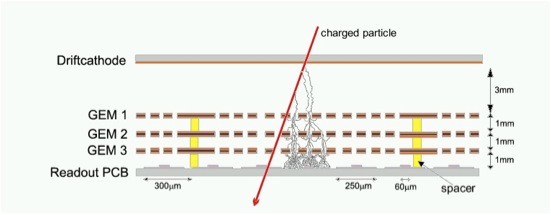Difference between revisions of "H Proposal Defense"
| Line 20: | Line 20: | ||
The electrons are fermions, negatively charged particles, located around the nucleus. Electron ionization is releasing the electron(s) of the gas from the domain of the nucleus. Any element has an ionization energy, the electron becomes free when it gets an energy higher than its ionization energy. | The electrons are fermions, negatively charged particles, located around the nucleus. Electron ionization is releasing the electron(s) of the gas from the domain of the nucleus. Any element has an ionization energy, the electron becomes free when it gets an energy higher than its ionization energy. | ||
| − | Lets have positively charged particle like a fission fragment with a certain kinetic energy in an argon gas, electron will starts scattering around the path in all direction | + | Lets have positively charged particle like a fission fragment with a certain kinetic energy in an argon gas, electron will starts scattering around the path in all direction for many reasons, but the starting point is bremsstrahlung radiation produced by the decelerating fission fragment,or by colliding directly with the gas atom. the primary electrons produced may also interact with the gas electrons and release more electrons through electron-electron interactions. |
In the case of low interacting particles with the gas, the number of the electrons released will not be enough to give an indication of the existence of this particle, so any electron produced primarily should be multiplied. | In the case of low interacting particles with the gas, the number of the electrons released will not be enough to give an indication of the existence of this particle, so any electron produced primarily should be multiplied. | ||
[[Image:Generic_SideView_GEMDetector.jpg]] | [[Image:Generic_SideView_GEMDetector.jpg]] | ||
| + | |||
| + | The free electrons are collected by the surrounding electric field toward a foil with holes, as the electron passes through one of the holes it will be multiplied. (ref.1) | ||
=References= | =References= | ||
Revision as of 15:52, 9 November 2010
Topic
The performance of a neutron sensitive gaseous detector based on thick gaseous electron multiplier detectors.(THGEM)
Introduction
Gaseous detectors using Gas Electron Multipliers [Suili refer] are becoming common in nuclear and high energy physics experiments. The Gas Electron Multipliers act as a preamplifier inside the detector allowing the detector's charge collection elements to decrease in size. The detector has has ability to detect the rare events in a high resolution.In addition to its flexibility to adapt any shape and any detection area needed for any experiment. Furthermore, THGEM is rebust,economic in design and operating.
Neutrons are nucleons with neutral charge, They interacts generally with high atomic number elements that have high cross sections for certain reactions.Mostly,the neutron interactions are represented by fission, capture,conversion (to an alpha or a proton) and scattering.
A neutron THGEM detector project is basically building the detector using the standards related to THGEM detectors, but adding to the detecting surface an element with a high cross section for a neutron interaction. In our case the THGEM foil will be covered by thorium-232 or uranium-238 which have relatively a high cross section for fission when the neutron energy range is between 5-14 MeV.
The THGEM neutron detector is supported by a read out wire net to get the signal, the read out wire net is connected to a gum stick and a break board, a software (coda) is responsible for collecting and filing the data, then analyzing the data by ROOT (software package).
Chapter 1
Sect1 electron Multiplication
The electrons are fermions, negatively charged particles, located around the nucleus. Electron ionization is releasing the electron(s) of the gas from the domain of the nucleus. Any element has an ionization energy, the electron becomes free when it gets an energy higher than its ionization energy.
Lets have positively charged particle like a fission fragment with a certain kinetic energy in an argon gas, electron will starts scattering around the path in all direction for many reasons, but the starting point is bremsstrahlung radiation produced by the decelerating fission fragment,or by colliding directly with the gas atom. the primary electrons produced may also interact with the gas electrons and release more electrons through electron-electron interactions.
In the case of low interacting particles with the gas, the number of the electrons released will not be enough to give an indication of the existence of this particle, so any electron produced primarily should be multiplied.
The free electrons are collected by the surrounding electric field toward a foil with holes, as the electron passes through one of the holes it will be multiplied. (ref.1)
